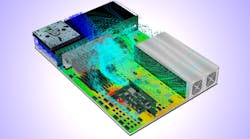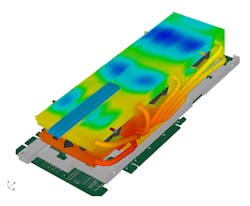The electronics industry exists in a continuous state of evolution. The world’s biggest companies are either launching new products, or refining and improving existing ones. In keeping with consumer expectations, manufacturers are under pressure to deliver sleek and slender designs with high-functioning hardware. The challenge is to fit increasingly powerful components into compact spaces without compromising the device’s performance. But increased power means greater heat output, and that can lead to some products quickly overheating—a significant issue that can impact device usability, reliability, and longevity.
As a result, it’s essential that engineers consider thermal management from the outset, rather than continuing to treat a product’s thermal properties as a separate design consideration. While thermal-simulation software is widely used in the electronics industry, it can still be a slow process. The complex equations involved in simulating fluid flow and heat transfer can take some time to solve, thus delaying the design process, slowing production rates, and impacting a business’ bottom line.
Refining Simulation Software
When the first iterations of thermal-simulation software entered the market in the 1980s, the computers of the time lacked the necessary processing power to simulate fluid flow and heat transfer in any complex form. This meant that design engineers had to rely on simulations of vastly simplified geometry comprising little more than a few thousand, if not hundred, grid cells. The time it took to get the results could vary from hours to days, and when it came to complex or experimental designs, the final output was often a drastic oversimplification.
However, as simulation software was refined—and the processing power of the computers improved—the number of grid cells increased. This meant that thermal engineers were able to get more accurate and reliable results, and a better understanding of how heat dissipated throughout a design. Structured
Cartesian grids enabled efficient and stable solving, but the uniform nature of the grid meant that regions of fine grid needed to resolve complex geometry traversed across the entire solution domain. This resulted in high grid counts and consequently high-processing requirements. As a result, engineers working without the latest computing hardware still faced lengthy waiting periods when it came to solving a thermal simulation (Fig. 1).
1. Here’s a thermal simulation of a heat sink being used to cool down a device.
Unstructured Gridding
To address this issue, computational fluid dynamics (CFD) experts and software developers began exploring the use of unstructured grids, which allowed for local alterations to the grid’s resolution (i.e., regions of fine grid where required) in order to match different levels of complexity across the design. By automating the generation of these grids, companies have been able to significantly reduce the amount of time and the processing power needed to simulate complex thermal designs.
The development of a “multi-level unstructured staggered grid Solver,” such as the one created by 6SigmaET, offers an efficient and creative way to solve the Navier-Stokes equations needed to portray an accurate simulation of heat flow throughout a product.
To start, a high-resolution grid is placed over the entire design of the model, after which a hierarchy of progressively coarse Cartesian grids are constructed. The Solver then identifies only those cells that are necessary to map out the design’s geometry. It’s due to this “in-built intelligence” that 6SigmaET’s Solver is able to ensure that the larger areas of a product’s design—those areas that that don’t warrant highly-detailed grids—are treated at a suitable resolution (Fig.2). This means that smaller and more complex objects are afforded a far finer simulation grid.
This approach has been successful in avoiding the various problems associated with alternative, unstructured simulation techniques, while also providing unparalleled performance. For thermal engineers, using the 6SigmaET Solver could see a design that would normally demand close to one billion grid cells simplified to just six million cells. This would ultimately provide an accurate solution in a matter of minutes, rather than hours or days.
2. In this image, the 6SigmaET thermal-simulation platform is being used to model and solve a design.
Numerous business benefits can be derived by reducing the time it takes to solve thermal simulations, too. By significantly saving both time and computational processing power, the multi-level unstructured grid solver is helping maximize the thermal efficiency of designs, cutting down the volume of project prototypes and other costs associated with production. Those saved cost could then be reallocated to future innovations, improvements, and additions to designs and existing product lines.
The Speed of Simulation
Resolving issues of thermal management in the latest designs is also important simply because for many thermal engineers, simulation remains an unnecessarily time-consuming process. It thus creates a bottleneck in the development process and generates costly delays in bringing products to market. According to research by 6SigmaET, two-thirds of thermal engineers in the electronics industry encounter such delays.
In its recent “State of Thermal” report, which surveyed 170 thermal engineers within the industry—including users of nine of the top thermal simulation suites—66% conceded that they faced a minimum of a day’s wait for their equations to solve. In contrast, 32% can solve their simulations in under an hour.
The report also highlighted a number of other hold-ups within the traditional thermal-simulation process. It found that 39% of thermal engineers are required to spend more than an hour importing CAD models from design suites into their current simulation platform. Meanwhile, 51% also consider the initial model creation stage to be too slow.
The research suggests a drastic difference in the capabilities of the various thermal-simulation packages on the market today. And yet, despite industry concerns over the length of time it takes to resolve thermal equations, 60% of thermal engineers admitted to having not changed simulation provider in more than three years, while almost half have never switched at all.
The preference for older software tools may come down familiarity, with some engineers preferring to use the system they know, rather than making the switch to a more modern, yet less familiar, tool. However, the efficiency gains that can be made from switching to more advanced, innovative, and up-to-date tools provide such an advantage that, by not switching, engineers are incurring otherwise completely avoidable time and cost penalties.
Overcoming the Challenge of Hardware Limitations
The “State of Thermal” research also revealed that nearly a quarter of thermal engineers admit that their organizations are struggling to keep up with the hardware requirements needed to support today’s resource-intensive thermal-simulation software packages.
This isn’t a shock. The complex nature of modern electronics means that most thermal-simulation software requires a significant amount of high-performance processing power to solve CFD. The issue is that this often requires a substantial, up-front investment.
The report shows that 81% of thermal engineers use desktop PCs or workstations to run simulations, while 25% rely on laptops. When it comes to solving simulations in this manner, engineers can find themselves hamstrung by cost constraints or slow upgrade cycles, which can lead to hardware that quickly falls behind the required performance levels for simulations.
The limitations imposed by the hardware are being removed by 6SigmaET. There’s integration with the latest cloud-computing platforms so that thermal engineers can access far more computing power that they would have access to “locally.”
This is a move that many in the electronics industry would support—36% of the thermal engineers surveyed agreed that their organizations would benefit from being able to solve their simulations in the cloud. This only serves to further expose the limitations of legacy simulation tools. And yet despite over a third of thermal engineers highlighting the benefits of the cloud, currently only 2% are using it for simulation solving.
Without the option to solve in the cloud, traditional simulation packages are simply unable to adequately support the current and future needs of thermal engineers. In contrast, 6SigmaET partnered with the Rescale high-performance cloud-computing platform to help engineers overcome hardware challenges. As a result, our users have access to as much as 1,400 petaFLOPS of computing power, delivered through Rescale’s 30 data centers and over 8 million servers.
This means we can allocate computing resources on an on-demand, model-by-model basis. For our customers, this means greater flexibility and reduced costs. Engineers would only pay for the processing power they require, using the hardware exactly how and when they need to. The result is access to an unparalleled and near-unlimited computing resource, enabling electronics engineers to solve up to 300 million grid cells in a single simulation.
Solving the Thermal-Simulation Challenge
We believe that thermal engineers can’t continue to rely on legacy simulation solutions. Not if they are to deliver accurate simulation results in limited timeframes, without compromise. Today’s thermal simulations need to be increasingly detailed—requiring both specialist software and powerful hardware—yet many engineers are continuing to test their designs on slow, unreliable, and outdated technology, despite the evident drawbacks.
A number of advances have been made in thermal engineering over the past decade, and there’s no reason for engineers to be spending days solving their simulations. It’s why 6SigmaET is simplifying its simulation suites, taking advantage of the latest technology and attempting to tackle the issues facing the electronics industry today. The goal is to make the future of thermal simulation faster, more flexible, and more cost-effective.



